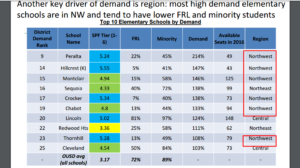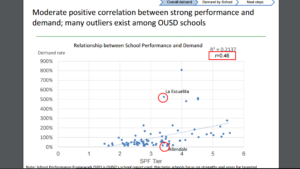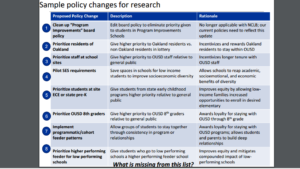Oakland Unified has been doing some powerful work in studying its own enrollment patterns and proposing policy changes to improve equity. This work will expose deep inequities, likely question some privilege, and hopefully start an honest conversation about how we work together to create better and more equitable schools.
The board will be hearing a report on this from the enrollment office at the 4/12/17 meeting. And while I often critique meetings for being more noise than signal, there is useful data in the presentations. So let’s dig into the enrollment data a little, look at some inequities, and see what we can do.
District enrollment rules tend to comfort the comforted and afflict the afflicted, to butcher a phrase. The highest performing and most demanded schools tend to be in the highest wealth neighborhoods. And because we often privilege neighborhood students in attendance at local schools, and parents with more resources tend to be able to navigate and exercise choices, those schools usually are less diverse. Rather than being an equalizer the system magnifies inequality.
The Northwest is the Best (based on demand)
Here’s the slide showing the most demanded elementary schools
Almost all of the highest demanded schools are in the Northwest, and Lincoln is the only school with over 50% free/reduced lunch. And all but one of these schools is in one of the top two tiers of performance.
These are public schools, but looking at Hillcrest, something just seems off, in a city that is 72% free/reduced? This is a public resource that should be shared more broadly.
Parents are good choosers but who is choosing
I would love to get some more information about who the actual choosers are and whether they are representative of the district. Public transportation can be very challenging in Oakland to go out of your neighborhood, so again resources may determine who can practically choose.
All that said, by and large, when we look the relationship between school performance and parental demand, parent tend to want to go to the higher performing schools. There is a fancy graph below, but basically if we see the schools (represented by the dots) clustering around the dotted line, it shows a moderately strong relationship between school quality and parental demand.
There are some other great nuggets in the data, and I look forward to more analysis going forward. But the big question, once we see the inequities is what we are going to do.
Next steps -policies and parents
Rightly, OUSD is beginning with community engagement sessions and a more detailed access study (thank you!) and they already have a set of specific policy changes proposed for study
There is some great stuff here, policies 4,5, and 8 would all explicitly work to increase equity and socioeconomic diversity. While other areas would enhance student stability or provide higher priorities to Oakland kids. These are all good changes, but a couple of things are missing.
What else?- Rezoning and Different Choices
One, we need to consciously study changing neighborhood enrollment boundaries to deliberately create diverse catchment areas. Racist zoning and relining practices created our current neighborhoods and correlate too closely with school quality maps. There is no need to honor those decisions. This will need to be thoughtfully done, but it could be done, and this is a sacred cow due to the slaughterhouse.
Second, people’s mindsets need to change. Many parents of many different races and statuses for many different reasons will tend to choose schools that are more like them. The private choices of individuals drive broader trends of segregation, KQED did a great job of showing the stark disparities between schools in the same attendance zone, based on the choices of parents. Parents, and particularly parents who are privileged with greater opportunities or resources, need to look at their choices consciously with an open mind, and vote for justice with their feet.
My colleague who writes the Integrated Schools Blog has asked parents to take the “two tours challenge” to visit 2 schools where your child would increase the diversity there, honestly and openly with no commitments. And I loved reading a recent success story from a mom who did it and chose a more diverse school.
So while policies matter here and the technocrats need to get it right, I think the most important thing we can do is hopefully have some changes of heart. We all benefit from true integration, and no matter how good your school is academically, you won’t learn the lessons you really need in isolation.





Thanks for another slate of sterling unpacking! Thanks also for crystal clear presentation!
appreciate that